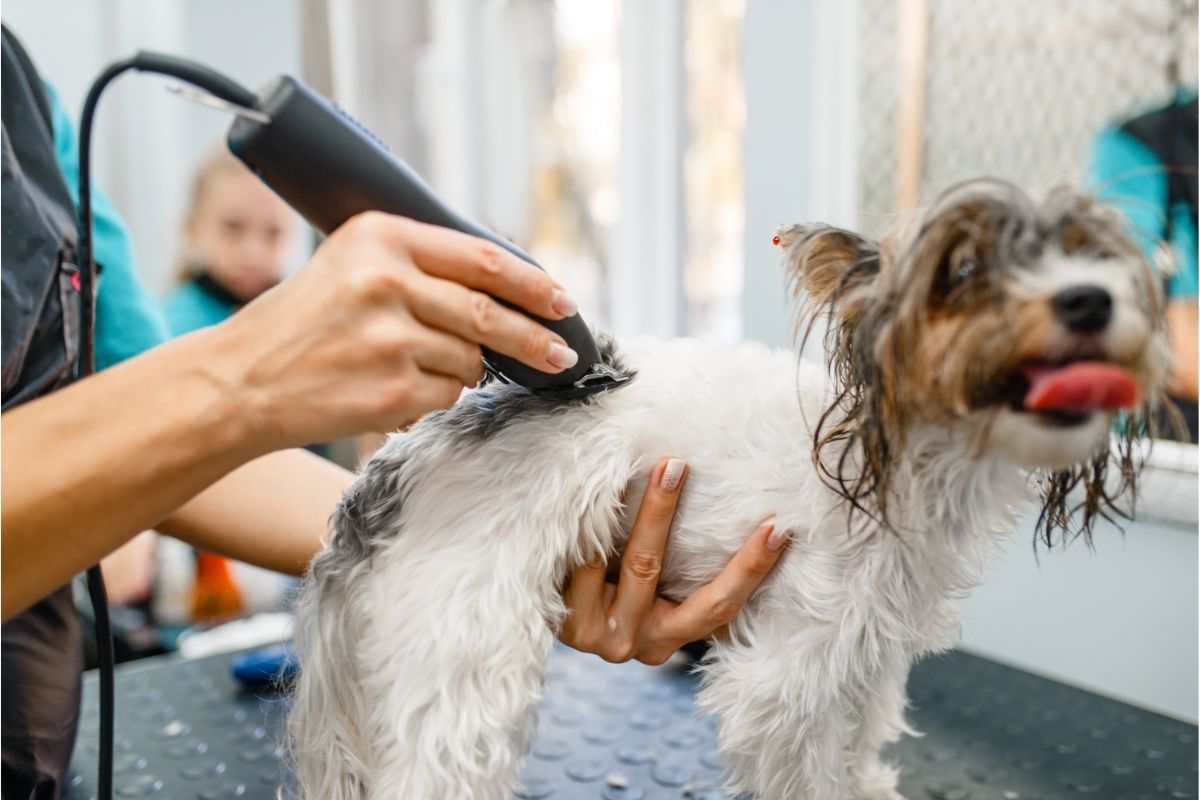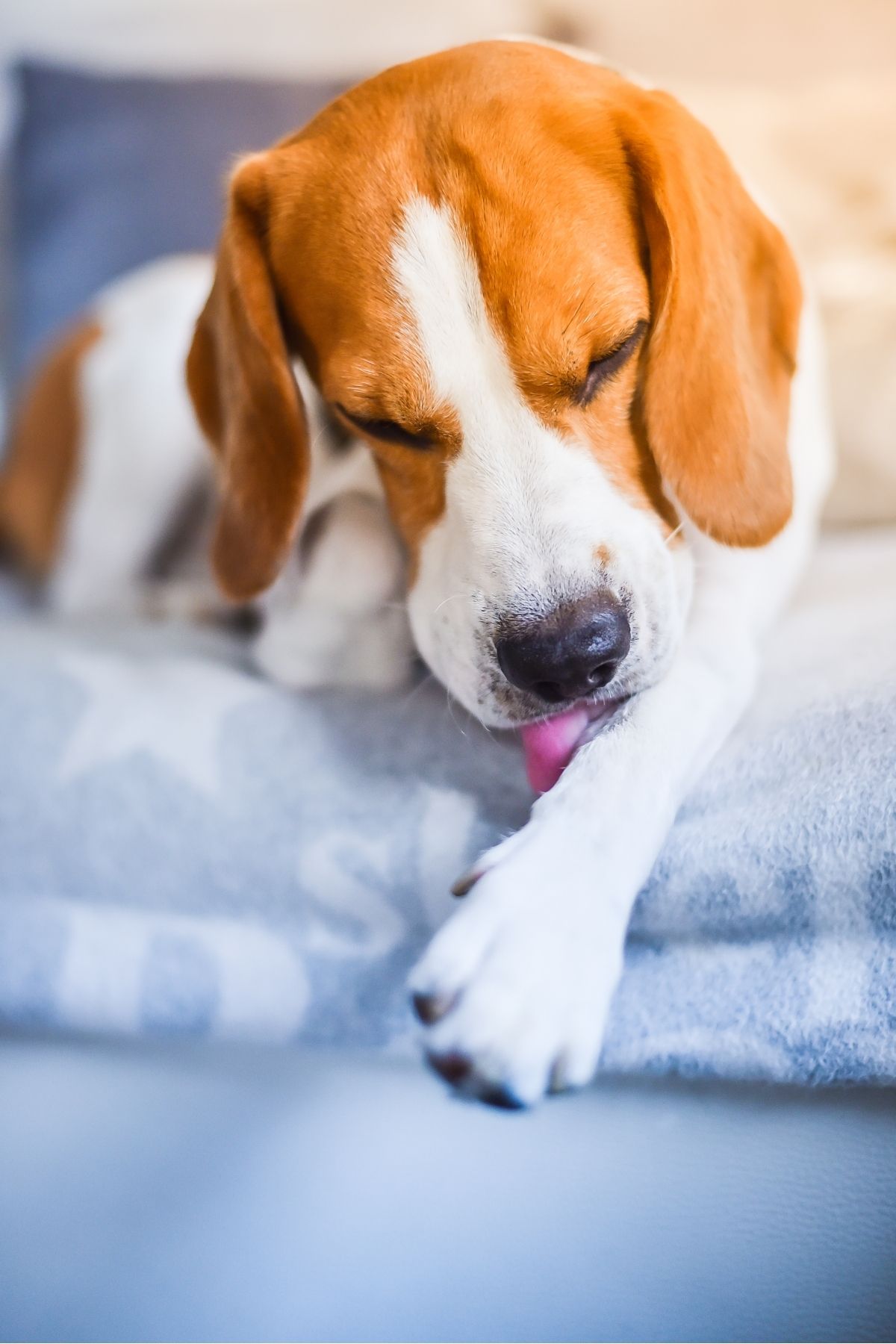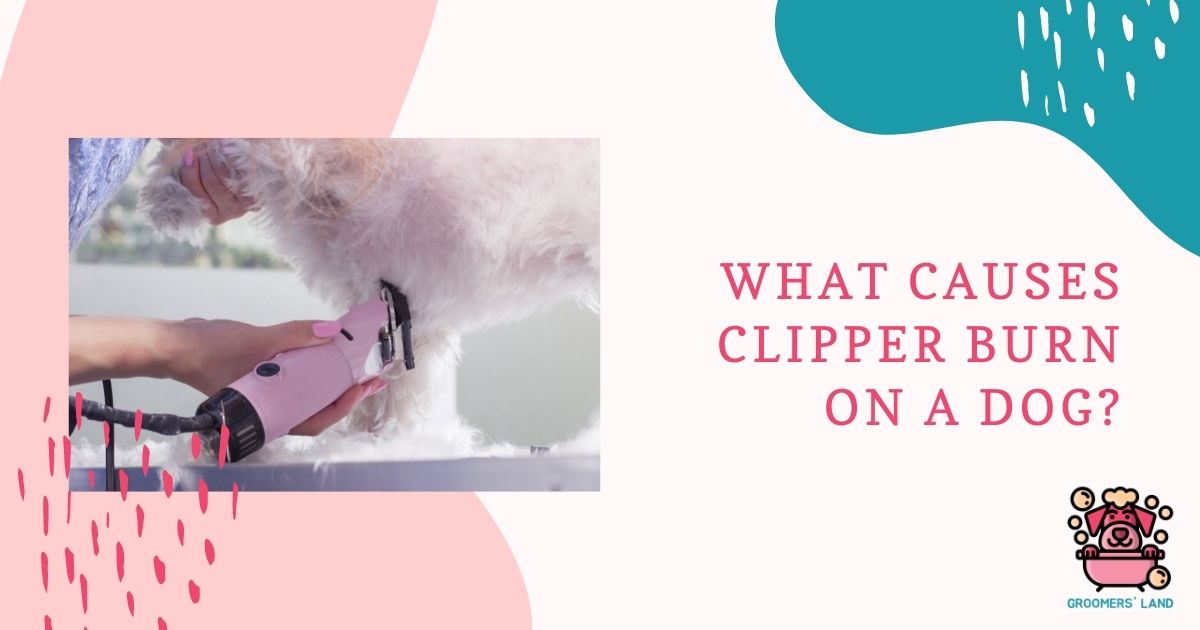What is Canine Clipper Burn?
Clipper irritation, also known as clipper sensitivity and clipper burn dog, is a skin irritation caused by using a clipper. It affects the top layer of the skin. It may not be a severe injury, but a pet’s skin may become itchy and painful. The skin becomes moister.
If you do not check or treat it, the scratching and licking can result in an open wound in a relatively short period.

What Causes Clipper Burn on a Dog?
Razor burns are relatively common. However, there are a variety of causes. The majority of individuals believe that the hot clipper blades are the source of the problem. However, this is only one of several variables that could have a role. Let’s have a look at what else could be going on in the background:
Dog Clippers With Dull Blades
Worn, dull blades are the most typical source of irritation. This is because such a clipper blade does not successfully cut your dog’s fur but instead pulls it. As a result, it causes skin inflammation, and a razor rash develops.
It is critical not to force or push your clipper if you believe it is not cutting correctly. This merely adds to the situation. If your blades appear to be worn, replace them right away. You should be aware that most cordless clippers have adjustable blades rather than detachable blades. As a result, replacing the blades on such goods is not an option.
Overheating of Clipper Blades
You’re undoubtedly worried about your dog burning with a hot clipper blade. This can happen to those with exceedingly sensitive skin. But, to be honest, I have never seen a dog that has a burn from a hot clipper blade. I’ve never heard of a case like this from a professional groomer.
Friction is the root of the problem. Friction alone dulls the blades, and the greater temperatures accelerate the process. Incredibly dull blades irritate the skin even more.
Skin Allergies
Some dogs’ skin is simply more sensitive than others. You should do grooming with caution if you have skin allergies. Many times, even if you’re doing everything right, you’re still giving your dog a clipper burn. If that’s the case, please handle it as best you can. If you take your dog to a professional groomer, tell him about his skin problems.
Clipping Too Closely
Razor burn is more likely when you clip your dog’s hair too closely together. Make sure you choose the proper blade size every time. You should avoid larger blades if you are not a true professional. However, in some circumstances, such as veterinary surgery, trimming or shaving too close is unavoidable.
Hair That Has Become Matted
Clipper burn is far more common in dogs with thick matted fur. Groomers have to make a closer cut due to the mats, which increases irritation.
Coats with mats also demand more significant pressure, and hair-pulling is regular. This hair conceals the problem that trimming reveals (such as a skin allergy). Mats also trap moisture, which encourages infection and makes the skin sensitive. So the final truth is that you don’t always upset your dog with the clipper.
Fleas
Fleas don’t specifically cause razor burn, and it isn’t even razor burn, but it’s worth mentioning. Stings from fleas are painful and can cause itching. When your dog’s lengthy hair gets cut off, exposing the skin, constant scratching might produce unpleasant symptoms.
It’s a good idea to get rid of all fleas and ticks well ahead of the grooming operation, and you should also consider preventive measures.
Skin Injuries and Diseases
If your dog has a thick coating of hair, it covers pre-existing skin issues, irritations, and injuries. Clipping, on the other hand, can cause problems to resurface. If your dog begins scratching and licking the sensitive area, the issue becomes worse.
Pressure
Groomers with less experience frequently apply undue pressure to dogs’ skin with clippers. As a result, discomfort and razor burn are unavoidable. However, never put too much pressure on yourself. Every clipper has a speed that you must sense.
What Happens if Your Dog Gets Clipper Burn While Being Groomed?
Is your dog itchy after grooming with a professional groomer? I understand that this is a delicate subject for you. But the essential thing is to remain calm in the face of adversity.
There are standards and rules in the grooming industry, although not all groomers adhere to them at all times. It is critical to have effective communication because clipper burn usually appears one to two days after grooming. It’s best to contact your groomer as soon as you notice symptoms.
You’ll be able to see what kind of blades they use on your dog and how long they are. Together, you can determine what changes you need to make to avoid unpleasant surprises following future grooming procedures.
When do Canines Experience Clipper Burn?
There are several experiences when your dog can get a clipper burn. This can be during the veterinarian visits. When a veterinarian works on a dog, they frequently shave it. This is necessary for sanitary and other health and safety considerations and different reasons.
The dog may develop clipper rash depending on his sensitivity and where you were shaving on him. This may be inevitable due to the need for a close shave to perform its required treatment. It is not uncommon to get clipper burn or razor rash. It commonly expresses itself as red, raw skin that may or may not have pimples on it.
The dog may lick or scratch the area in question. This condition is a result of cutting closely of the dog’s nails. It further leads to inflammation of the skin. The dog may be new to such a close shave, or it may have susceptible skin, in which case you need to consider a more careful approach. However, this does not necessarily imply that the groomer is at fault.
What do you do when your dog comes home from the groomer with a clipper burn on his coat? Excessive scratching or licking in a particular place, as well as rubbing his face against the carpet, are all signs of irritation.
This is usually a result of using a clipper blade that shaves too near the skin. There are some “rules” in the grooming profession regarding the length of the blades that you should use on different regions of the body.

Signs of Clipper Burn on Dogs
Symptoms of clipper burn on dogs include red markings or lines on a dog’s skin, which usually appear in sensitive places such as the stomach or groin. Burning can occur for various causes, including blades that are too hot or too dull to cut effectively. If your dog suffers clipper burns, therapies are available to alleviate the discomfort.
The top ten most common dog grooming injuries include:
- Dog razor burn
- Nicks and scrapes
- Irritation of the ears
- Overgrown nails
- Irritation of the anal glands
- Irritation of the eyes
- Matting for sanitary purposes.
How to Treat Clipper Burn on a Dog?
Clipper burn is a painful and sadly common condition on dogs, causing them to scratch and itch. Symptoms of clipper burn include red markings or lines on a dog’s skin, which usually appear in sensitive places such as the stomach or groin.
Burning can occur for various causes, including blades that are too hot or too dull to cut effectively. If your dog suffers clipper burns, therapies are available to alleviate the discomfort. You can follow the following steps for clipper burn treatment.
Step 1
Maintain the dryness of the area. Generally speaking, irritations heal the fastest when you keep them dry and expose them to air. A moist or damp place can lead to more infection or irritation resulting in further complications.
Step 2
According to the United States Kerry Blue Terrier Club, you should poke a hole in a vitamin E capsule and carefully rub the capsule’s contents on the specific area. When it comes to natural skin remedies, vitamin E is one of the best.
You should apply it at least once a day until the irritation resolves. You should use lanolin and aloe vera gel daily until the burn heals. Both are natural remedies for clipper burn.
Step 3
To soothe and aid in the healing of the burn, apply an over-the-counter steroid cream or ointment to the area in question. Use the creams daily until the burn heals.
Step 4
Bathe your dog in a shampoo that contains oatmeal to soothe inflamed skin, such as the ones available at pet stores. Using warm or cool water, thoroughly rinse away any remaining shampoo. According to the instructions on the bottle, determine how long you should let the shampoo soak and how frequently it is safe to use it.
Step 5
Purchase items specifically for soothing clipper burn on dogs and apply them to the specific regions following the product’s guidelines. You can find these lotions and gels in pet supply stores. For grooming and shampoo goods, you can find them in the grooming or shampoo sections.
A Home Remedy for Dog Clipper Burn
You can select from various therapies, including natural and non-natural options.
- Aloe vera: Aloe vera is well-known for its anti-inflammatory and antiseptic properties. However, you should use caution when dealing with this plant. This is because saponins, which are harmful to dogs, are present in the pure gel derived from aloe leaves. There are suitable canine products available, but you should always consult your veterinarian. Although its name implies acidity, hypochlorous acid has a neutral pH and effectively treats a variety of skin irritations. It’s produced primarily by white blood cells in reaction to infections. That is why it works so well. Vetericyn is one of the most widely used hypochlorous acid products.
- Antibiotic ointments: Antibiotic ointments are excellent for clipper burn, especially if the area on treatment has some infection. One of the most popular products containing such ointment is Neosporin. Because some dogs may be allergic, you should also visit your veterinarian. Because it has fewer ingredients, the ointment form is preferable to the cream version. Also, avoid products that contain painkillers, as canines negatively react to them.
- Vitamin E: The health benefits of vitamins are undeniable. Vitamin E, for example, is a natural skin treatment that efficiently cures discomfort.
In addition to the ointments, gels, and drugs listed above, your veterinarian may recommend other steroid-containing ointments, gels, and medications. I try to stay away from them, but I always advise listening to the expert of your choosing. Your veterinarian is the expert on your dog.
How to Avoid Clipper Irritation in Canines
Clipper burn is a problem that can develop from time to time. The treatments listed above are pretty effective, but the best course of action is to do everything you can to avoid inflammation.
Whether you’re a professional groomer, a dog owner who brings your dog to a groomer regularly, or someone who grooms their dog at home, the advice below will come in handy.
Ask Your Groomer
If you aren’t grooming yourself, you should speak with your groomer before the appointment. If you are working with a new dog groomer, tell him about your previous experiences.
He needs to know if your dog has any skin issues or sensitivities and the blade size causing the dog grooming cuts issue. Even if you wish to clip your dog’s fur yourself, it’s still a good idea to get professional assistance.
Carefully Select Your Blades
Remember that one of the primary causes of dog razor rush is overly close cutting. Make the best choice for your clipper blade. For dogs with delicate skin, I don’t advocate blades larger than #10.
Only Use the Clip Once
Always try to clip a region once. This can be difficult with a matted coat, but it shouldn’t be an issue with a heavy-duty clipper. Be ready for the clipper burn to show up if you have to go over a section of your dog more than once.
Invest in a Good Dog Clipper
This topic, in my opinion, we should not over-explain. With a low-quality tool, don’t anticipate good outcomes. Andis, Wahl, and Oster are among my particular favorites. These firms make the top professional dog clippers.
Lubricate Your Blades
Oiling the blades prevents them from overheating and extends their life. These results are beneficial because they dramatically minimize the risk of clipper burn.
Sharpening of Blades
Don’t be afraid to do so if you need to sharpen your dog clipper blades. Of course, if you’re a typical DIYer, this isn’t a problem. Sharpening blades is a service that you can find in several firms. However, you can also purchase replacement blades. It’s important not to begin your grooming routine with stale items.
Check the Temperature of the Blades
You can immediately determine whether or not your clipper blade has much heat. Place it on your forearm; if it is too hot, wait for the blade to cool off if necessary, or replace it with a new one. For this purpose, cooling sprays are available in the market.
The Clipper Must Be Clean
Various pollutants can cause snags and other failures in dog clippers. Razor burns are more likely to occur as a result of such flaws. As a result, you must clean your grooming instrument regularly.
Moisturizing
Moisture will exacerbate the clipper burn if it occurs. On the other hand, moisturized healthy skin makes it more resistant to irritation. A good dog wash and a balanced diet will help your dog’s skin stay healthy.
The Skin of Your Dog
As previously said, some dogs’ skin is simply more susceptible to clipper burns than others. You might want to get to know your dog’s skin so you (or your groomer) are ready for any adverse outcomes.
The following suggestions may assist you in resolving this problem in the future.
- Allow your dog to lick the treated or wounded area: It is natural for your dog to want to lick the inflamed region of the skin. It does, however, significantly lengthen the time it takes to recover. Furthermore, if your dog consumes the creams or drugs required for treatment, it might cause a slew of issues. The Elizabethan Collar is a great way to keep licking at bay.
- Use the same groomer every time: You should always use the same groomer as a dog owner. You can still ask the same person if you go to a salon with many groomers. After all, it’s critical to begin the session with a professional who is familiar with your dog’s skin and fur.
- Examine the following locations for regions where your dog is continually licking: These are significantly more sensitive locations. The skin is considerably redder, and the hair is generally sparse or discolored, making them easy to spot.

Conclusion
Knowing how to treat clipper burn on a dog will save your puppy from suffering and the possibility of infection in the future. You should be careful about dog skin problems after grooming.
Communication with your dog’s groomer is also essential to develop a possible solution. The veterinarian will also play a vital part in this situation, especially if you discover that the clipper burns have an infection.
Have you ever had to treat your dog for clipper burns? What steps did you take to cope with it? Please tell us about your experience!


2 thoughts on “What Causes Clipper Burn on a Dog?”
Comments are closed.